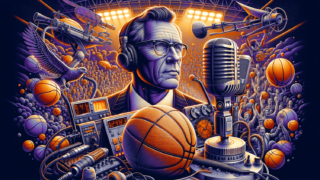
Role of Broadcasting in Growth of Basketball
Written by: Basketball Universe
Last updated:

Get ready, hoop fans, for an exciting journey to explore one of the most pivotal aspects in the thrilling world of basketball: the power of broadcasting! 🏀 The evolution of broadcasting has played a slam-dunking role in popularizing this high-flying sport and captivating audiences around the globe. In this engaging blog post, we’re going to swirl around the court and dive into the artful alley-oops of broadcasting, as it shapes our understanding and appreciation of the game. Fasten your sneakers, and let’s hit the hardwood together as we examine how television networks, radio waves, and the ever-evolving internet continue to transform and immerse us in this captivating sport we all know and love—basketball!
Role of Broadcasting in Growth of Basketball
Broadcasting has played a crucial role in basketball’s growth by popularizing the game, expanding its reach, and drawing larger audiences worldwide. Through television, radio, and the internet, broadcasting has allowed fans to follow their favorite teams and players, fostering a passionately engaged community. High-quality live coverage, in-depth analysis, and easily accessible content have also attracted new fans, making basketball a global phenomenon. Additionally, the financial resources generated through broadcasting rights have significantly contributed to the sport’s expansion, enabling investments in player development, infrastructure, and marketing efforts.
From Radio Waves to High-Def Screens: Revamping the Basketball-viewing Experience
As broadcasting technology has evolved, so has the way we experience basketball. Let’s take a trip down memory lane and appreciate how far we’ve come in observing and celebrating our beloved game.
Radio: Setting the Stage for Future Broadcast Stars
In the early days of basketball history, radio broadcasts were the primary means through which the game reached the masses. The voice of the broadcaster resonated with fans, painting vivid pictures of fast breaks, buzzer-beaters, and high-flying dunks. Soon, radio broadcasting blossomed into the first foray into sports journalism, setting the stage for the analysis and commentary we know today.
Television: Bringing the Game to Life
With the advent of television, basketball fans could now watch their favorite teams and players in action, transforming the spectator experience forever. As networks like NBC, CBS, and later, the iconic NBA on TNT, arose, fans became increasingly connected to live games, thrilling playoffs, and unforgettable moments, fostering a deeper emotional investment in the sport.
High Definition and Beyond: The All-Access Pass
High-definition broadcasts have further revolutionized the basketball-viewing experience. The razor-sharp clarity and attention to detail have brought fans even closer to the action, elevating their understanding and appreciation for the nuances of the game. The introduction of various camera angles and instant replay technology has also provided new perspectives, dissecting key plays and moments for a more comprehensive view of the sport.
From Glocalization to Globalization: Expanding the Fanbase
Broadcasting has played a vital role in propelling basketball’s popularity far beyond its origin in North America. Fans from around the world have fallen in love with the sport, sparking unprecedented levels of attention and competition.
International Growth of Basketball Leagues
The global broadcasting of basketball games, particularly those of the NBA, has ushered in an era of unprecedented international expansion. This exposure has fueled the creation and growth of basketball leagues worldwide, such as the EuroLeague, the Chinese Basketball Association (CBA), and the Australian National Basketball League (NBL), to name a few.
Sharing the Love for Basketball across Continents
Broadcasting has introduced the exhilarating game of basketball to millions of fans, irrespective of their geographical location. International broadcasting deals have made it possible for fans to watch games in different languages, ultimately nurturing communities of enthusiasts around the globe, from Australia to Argentina and South Africa to South Korea.
The Emergence of Global Stars
As the game reaches new corners of the world, it comes as no surprise that international players have emerged as some of the brightest stars in basketball. Broadcast exposure has allowed fans to follow the careers of icons like Dirk Nowitzki, Yao Ming, and Giannis Antetokounmpo, further solidifying the sport’s appeal and influence on a global scale.
Enriching the Fan Experience: Going Beyond the Court
The role of broadcasting in basketball goes beyond merely presenting gameplay. It delves into analyzing game strategies, providing insights into players’ lives, and presenting fans with opportunities to learn more about the sport and its culture.
Pre-Game, Halftime, and Post-Game Analysis
Broadcasting has introduced fans to in-depth game analysis, providing a platform for experts to dissect gameplay, players’ skills, and strategies. From pre-game predictions to halftime discussions and post-game breakdowns, fans can access a wealth of knowledge to deepen their understanding of the sport.
Documentaries and Reality Shows
Broadcasting has opened the doors to an array of basketball documentaries and reality shows, such as ESPN’s critically acclaimed series, “30 for 30,” and Netflix’s “Last Chance U: Basketball.” These productions offer fans unique glimpses into players’ lives, their personal and professional challenges, and the passion that drives them to achieve greatness.
New Possibilities: Interactive and Augmented Reality
As technology continues to advance, broadcasting has increasingly reached out to fans with interactive and augmented reality applications. Fans can now engage with their favorite teams and players through brackets, fantasy leagues, and other immersive experiences—further strengthening their connection to the sport.
Empowering Basketball’s Next Generation: Influence on Player Development
From college prospects to seasoned pros, broadcasting has supported player development by offering more exposure, encouraging growth, and enhancing the recruitment process.
College Basketball: The Path to Stardom
Broadcasting has empowered the next generation of basketball stars by shining a spotlight on college basketball. Networks like ESPN and CBS have consistently dedicated extensive coverage to college games, particularly the NCAA March Madness tournament, allowing young talents to display their skills on a larger stage and make the leap to professional basketball.
Recruitment and Exposure
High school basketball games, AAU tournaments, and even pickup games are now routinely broadcasted, providing aspiring athletes the opportunity to showcase their skills to recruiters, scouts, and fans. Video and streaming platforms have become indispensable tools, offering players more chances to impress and ultimately secure coveted spots in prestigious programs or professional leagues.
Player Development Stories
Behind-the-scenes content has granted fans unique access to the ups and downs of player development stories. Broadcasting these journeys not only humanizes athletes but also serves as inspiration and motivation for up-and-coming players who aspire to achieve similar success.
The Economic Force Driving Basketball’s Success
The essential role of broadcasting in basketball extends to its profound impact on the sport’s financial landscape. With lucrative broadcasting deals and advertising opportunities, the economic resources generated have contributed significantly to basketball’s overall growth.
Major Broadcasting Deals: NBA, NCAA, and Beyond
Over the years, major broadcasting deals have created immense financial value for leagues like the NBA and tournaments like the NCAA’s March Madness. As a result, these organizations have been able to invest in player salaries, arena improvements, and marketing efforts, ultimately boosting basketball’s global appeal.
Advertising and Sponsorships
The high viewership numbers from basketball broadcasts have created myriad advertising opportunities, attracting big-name sponsors to invest in the sport. These sponsorships not only generate substantial revenue but also increase brand visibility and product endorsements, tying the world of commerce more closely to the game of basketball.
Creating Employment Opportunities
Broadcasting has also contributed to the generation of job opportunities within the sport. From commentators, analysts, and directors to camera operators, editors, and designers, the broadcasting industry creates employment for thousands of basketball-loving professionals, enriching the overall ecosystem of the game.
With its unmistakable impact on the game, broadcasting has left a lasting legacy on basketball. As the sport continues to flourish, the role of broadcasting will remain indispensable in shaping its future, captivating new audiences, and championing the exciting world of basketball.
Embracing the Digital Age: Online Streaming and Social Media
The meteoric rise of the internet and social media platforms has fundamentally transformed the ways in which basketball games are broadcasted and consumed. With more accessible and diverse content made available to fans, the online space has played a crucial role in the growth of basketball.
Streaming Services: A New Era of Accessibility
Online streaming platforms have become a staple in the landscape of basketball broadcasting, rendering games and related content more widely available to a global audience. Services such as NBA League Pass, ESPN+, and even social media platforms like Facebook and Twitter have amplified the reach of live games, highlights, and interviews—redefining the fan experience across laptops, smartphones, and tablets.
Social Media: Fostering a Passionate Basketball Community
Platforms like Twitter, Instagram, YouTube, and TikTok have emerged as pivotal channels through which basketball content is shared and discussed. By providing up-to-date information, engaging discussions, and real-time reactions to games or highlights, social media has become instrumental in fostering the growth of basketball’s vibrant online community.
Podcasts and Online Shows: Deepening Fan Involvement
Basketball podcasts and online talk shows have soared in popularity due to their highly engaging discussions, interviews, and game-related content. By delving into compelling narratives, unseen perspectives, and fascinating basketball history, these media sources have significantly contributed to deepening fans’ interest and involvement in the sport.
Women’s Basketball on a Global Scale
Broadcasting has played a pivotal role in supporting the growth of women’s basketball, both domestically and internationally. Through enhanced visibility, equitable coverage, and improved financial resources, the sport has experienced a surge in participation and recognition, shining a light on the achievements and talent of female athletes.
Increase in Visibility: NCAA and WNBA
Domestic women’s leagues, such as the NCAA and the WNBA, have seen a significant increase in broadcasting coverage, ensuring that female athletes receive the recognition they deserve. With more televised games and higher viewership, women’s basketball has enjoyed substantial growth in recent years—indicating a bright future for the sport.
International Broadcast Exposure
Women’s basketball leagues worldwide have also benefited from expanded media coverage. The broadcasting of international events like the FIBA Women’s Basketball World Cup and the EuroBasket Women has been pivotal in inspiring and engaging fans across nations, empowering the next generation of female basketball players.
Equitable Investment in Women’s Basketball
As a result of increased exposure and viewership, there has been a rising tide of equitable investments in women’s basketball. With more lucrative broadcasting deals and sponsorships, the sport has experienced considerable growth in resources, propellant factors for enhanced infrastructural development, marketing efforts, and player salaries.
Looking at the multitude of ways broadcasting has impacted and shaped the game—from boosting its popularity and expanding opportunities for athletes to fostering communities of fans and generating significant financial resources—it is clear that the continued evolution of broadcasting will undoubtedly propel basketball to new and exhilarating heights.
Frequently Asked Questions (FAQs)
Still curious about basketball broadcasting and its impact on the sport? We’ve compiled a list of the most frequently asked questions to address any lingering inquiries, covering various aspects of broadcasting’s influence on basketball.
1. How has the internet impacted the broadcasting of basketball games?
The internet, with the advent of online streaming platforms and social media, has revolutionized the way basketball games are broadcasted and consumed. Streaming services have expanded global accessibility, while social media has fostered a vibrant online community that shares and discusses basketball content in real-time.
2. How does broadcasting affect basketball players’ careers?
Broadcasting plays a significant role in athletes’ careers by providing exposure, allowing them to showcase their skills and talent to scouts, recruiters, and fans. This increased visibility can lead to professional opportunities, endorsements, and a higher market value for players seeking contracts.
3. Can broadcasting affect basketball player performance?
Yes, broadcasting can affect player performance, though effects vary from person to person. The pressure of playing in front of millions of viewers and knowing that each move may be scrutinized can potentially impact a player’s mentality, leading to a change in their on-court performance, either positively or negatively.
4. How is the WNBA influenced by broadcasting?
Broadcasting impacts the WNBA by offering increased visibility, attracting more viewers, and driving sponsorships and advertising opportunities. This, in turn, allows for greater financial resources and infrastructural development. Recent efforts have been made to ensure equitable coverage and representation for female athletes in the sport.
5. How has broadcasting changed the way college basketball is covered?
Broadcasting has contributed to wider coverage of college basketball, particularly the NCAA March Madness tournament. This exposure provides young athletes with greater opportunities to showcase their talent, making the transition to professional basketball smoother and more attainable.
6. How do social media platforms boost basketball viewership?
Social media platforms, such as Twitter and Instagram, facilitate real-time sharing of basketball content, including live game updates, highlights, and commentary. The convenience and immediacy of these platforms have contributed to increased basketball viewership, fostering a larger and more engaged fanbase.
7. What new technologies have been implemented in basketball broadcasting?
New technologies such as high-definition broadcasts, multiple camera angles, instant replay systems, and augmented reality applications have been introduced in basketball broadcasting. These innovations have significantly enhanced the viewer experience, providing unparalleled perspectives and insights into the game.
8. What role does broadcasting play in the growth of international basketball leagues?
Broadcasting has played a central role in the international expansion of basketball leagues by globalizing the sport and capturing the attention of audiences worldwide. This exposure has spurred the growth of basketball leagues beyond North America, such as the EuroLeague, CBA, and NBL.
9. How does broadcasting help develop audience engagement?
Broadcasting encourages audience engagement by presenting games, as well as pre-game, halftime, and post-game analysis that informs, educates, and entertains fans. Additionally, new technologies such as interactive applications, augmented reality, and fantasy leagues enable fans to interact with their favorite teams and players in brand new ways.
10. What potential future developments could we see in basketball broadcasting?
We could see developments such as enhanced virtual reality experiences, which would enable fans to immerse themselves in games from the comfort of their homes. Other potential advancements include streamlined global distribution, personalized viewing options, and more interactive features to further amplify fan engagement.
Featured Posts
- No pillar pages found.




